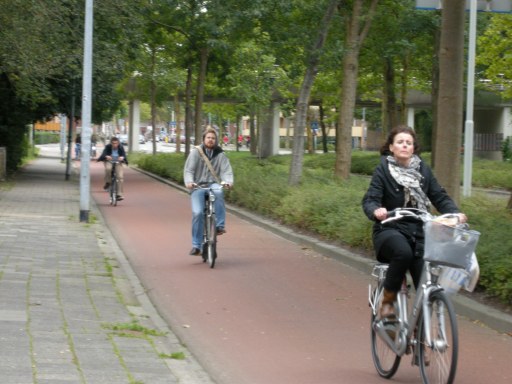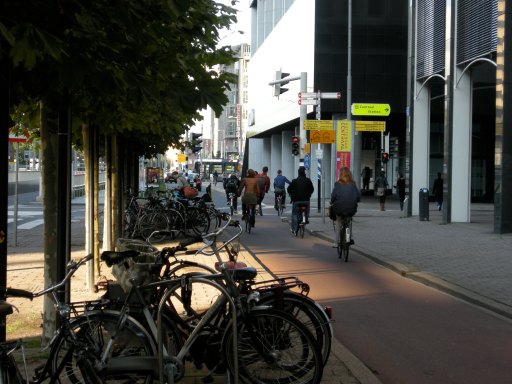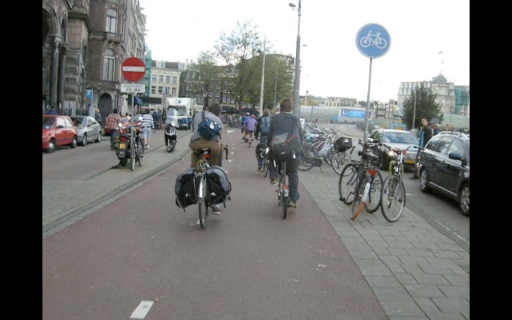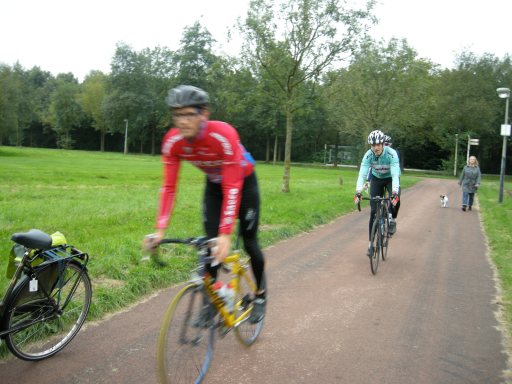Love London, Go Dutch - 1) Choice?
This is the first of four posts on the London Cycling Campaign's Love London, Go Dutch campaign. The next three are here, here and here.
While I think it is indisputable that the London Cycling Campaign have done a fantastic job in in embracing and enthusiastically promoting their Love London, Go Dutch campaign, and pushing it firmly up the political agenda, there are some grounds for concern about how it might be implemented in practice.
The principles, as set out in detail, are decent enough, but I am troubled by some misintepretations that appear to be creeping in, and that could potentially open up the door for either half-hearted provision that really isn't up to scratch, or for Boris to claim that he might choose to do for cyclists is 'Dutch', in some way, shape or form.
The first problem I have diagnosed, and which I will discuss in this initial post, is perhaps the most serious. It's an incipient (or perhaps innate) notion that there are two distinct categories of cyclist; those that are happy cycling on the road, and who would continue to cycle on the road once 'provision' has been put in, and another category of cyclist, made up of those who are more nervous, or who don't currently cycle but who would like to, for whom the infrastructure is being provided. Further, and problematically, this categorisation extends to the notion that these two distinct types of cyclist will require two different approaches to their cycling needs.
This attitude has manifested itself in the appearance of Advanced Stop Lines (ASLs) in the carriageway, alongside segregated provision for the 'other type' of cyclist, in LCC's illustrations of their schemes for both Blackfriars and Parliament Square. 
In my opinion, these ASLs are indicative of a troubling outlook; it suggests that the LCC have already assumed that their cycle tracks are going to be inadequate; so inadequate, that a large number of cyclists are not going to want to use them.
Of course, this position is framed as 'choice'. That, as the LCC is a democratic organisation, they should not rule segregation either in or out, and cyclists in London should be free to use either the carriageway or the new provision. It was this argument that was employed by Richard Lewis, the designer of these schemes, in his presentation of Go Dutch at the Movement for Liveable London's Street Talks in April. 
The word 'choice' is the first one that appears on this slide of his, about the 'principles' of infrastructure. Richard had this to say -
I've put 'choice' up there because LCC is a democratic organisation... Some people like the segregated tracks, some people like to use the streets. I like to allow people to use both, if they want to. But for those people using tracks, in circumstances where they're provided, they need to be good enough for people, whoever they are, to use them, and choose to use them. If they're not good enough, people will choose not to use them. They'll vote with their wheels. And I think we need to give them that opportunity, as a kind of test to see what kind of quality we've achieved.
This is more than a little uninspiring. The LCC are effectively starting from a blank slate - they can design and present the quality of infrastructure they think is desirable. Yet within their very own designs, they are putting in features that imply their own designs will not be good enough.
Indeed, it begs the question of why people would not like to use the segregated tracks. Put bluntly, if cyclists, of any stripe, are wanting to continue using the carriageway, then the design must be a failure. It implies that the design is too narrow (you can't easily get past other cyclists, for instance). Or that the corners are too sharp. Or that you are being held at traffic lights, while motor traffic is privileged. Or any of the above. In short, your journey on the infrastructure will be slower and more arduous than it would be on the carriageway.
This is what those ASLs represent - an admission that the infrastructure the LCC is designing is not up to standard. In other words, the LCC have tacitly made an admission of failure, before they have even started.
Now I'm not quite sure how the LCC arrived at this 'choice' interpretation of Go Dutch, because it certainly isn't a Dutch principle - Dutch infrastructure is designed to a standard suitable for all cyclists - nor does it appear in LCC's own Principles in Detail.
To speculate, I think the most probable reason is that the LCC don't want to alienate or upset those of their members who have a strong attachment to 'vehicular' cycling. Without wishing to pick out any blog or writer in particular, this recent piece by Patrick Field is indicative of the LCC attitude more generally. Entitled 'free to choose', Patrick asks us if
There’s no practical problem with a full-hearted endorsement of the important principle that the choice between riding on the highway, and using any parallel cycle-infrastructure, is best left with the individual?
Patrick shows us this picture of Argall Way in East London -

and claims that what it represents is
theoretically perfect because it has cycle-tracks on either side offering respite from any status problems people on bikes might feel about taking space on the carriageway while at the junctions there are – now somewhat faded – advance stop boxes, which signal clearly that cycle traffic is also welcome on the highway.
This is muddle-headed, for reasons that I will detail below. An immediate and obvious objection is that the off-carriageway provision shown here is just about the opposite of 'perfect', in that while it does allow people to cycle away from motor traffic, it is of a desperately poor standard, and deeply inconvenient (indeed, like most UK off-carriageway provision). What Patrick has written is pervaded by an attitude that off-carriageway provision, of a very low standard, is fine for slower, nervous plodders; an attitude that contains within it an assumption that the road itself should still carry markings to 'signal' to drivers that cyclists not willing to use that very same crap can still use the road.
Why I say this is a muddle-headed attitude is because I don't think it would be unfair to say that this group of cyclists - 'faster' cyclists, people like Patrick and indeed me - are objectively all that concerned about how, precisely, they might make their journeys across London, as long as those journeys remain as fast and as convenient. For instance, I'm not sure many London cyclists would choose to cycle amongst HGVs and taxis if an off-carriageway track or path was just as useful, and safe, to them as the road shared with those lorries and taxis.
But unfortunately we are in a position where plenty of cyclists in London - those like Patrick - have got it into their heads that off-carriageway infrastructure is for 'slow' cyclists, and will always be like that, and consequently the road should remain the place for 'fast' cyclists.
You can hardly blame them for this, of course, given that the mostly crappy off-carriageway provision in London, just like that seen on Argall Way, forces people to go slow, and that most London cyclists have little experience of how fast you can go on Dutch infrastructure.
These attitudes were sadly mirrored by Richard Lewis himself, who said, while comparing Danish and Dutch infrastructure during his presentation, that
You are a lot more like a vehicular cyclist in Denmark than you are in the Netherlands, where you are much more of a pootling cyclist. The Dutch stuff encourages slower cycling - which some people say is more civilised, and perhaps under certain circumstances it is.
That is, Going Dutch is taken to mean putting in some infrastructure that will allow nervous people to 'pootle about', while the carriageway itself remains the place for cyclists to 'make progress'. This interpretation of Dutch infrastructure, I think, goes some way towards explaining why the designs that the LCC have come up with are so keen to continue providing a place for cyclists 'on the road'; because they think Dutch provision is for a slower category of cyclist. (Perhaps that attitude has also been coloured by how we are forced to cycle on current off-carriageway provision in the UK).
This is simply wrong, of course; you can cycle very fast on nearly every single Dutch cycle path. They are nearly always smooth and wide. In Groningen - 

In Rotterdam -
In Amsterdam -
In Assen -
And in Utrecht.
You may indeed encounter 'slow cycling' on Dutch cycle paths, but this never a function of the design - it is a function of the fact that some of the people on those cycle paths will not be able to cycle fast - namely young children and the elderly. But it seems that faster cyclists in the LCC have a fear of being trapped behind a load of 'pootlers' on narrow tracks. The ASLs are their metaphorical, and literal, escape route.
The correct approach should, of course, be to make the cycle tracks wide enough to prevent any such conflicts, to create 'roads for bikes', that will be pleasant for all to use, regardless of speed or ability or confidence. This should be the starting position of the LCC; not one that apparently assumes that conflicts and poor design will be inevitable from the get-go.
Of course the LCC's 'dual track' approach - seeking to keep cyclists on the carriageway, while also providing off-carriageway tracks - may not be problematic, in and of itself; it should be theoretically possible to build decent infrastructure while still allowing cyclists to use the road itself, and putting 'signals' on it to that effect. But unfortunately there will almost certainly be implications for the quality of off-carriageway provision if you insist that large numbers of cyclists will still want to use the main carriageway. Imagine a potential conversation like this, between LCC and TfL, as they consider some of LCC's plans -
TfL - What are those ASLs on the road for?
LCC - They're for cyclists who want to continue riding on the road.
TfL - Why would they want to do that, when we're putting in these fantastic wide, smooth cycle paths?
LCC - It's because some cyclists want to continue to ride fast. We can't do that on cycle paths.
TfL - Oh right. I see. So the cycle paths are for people who don't mind cycling slowly. [With that in mind, goes away and designs compromised facility that is narrow and suitable for 'pootling', in other words very similar to the compromised awfulness that has been put in for decades]
If your starting position is that cycle paths and tracks are for people who want to cycle slowly, and don't mind doing so, you are storing up trouble by maintaining, or even creating, attitudes about how that infrastructure should be designed. You are effectively opening the door to the provision of rubbish infrastructure, and, just as bad, you are undermining any objections you might have as to its quality. Say you want to complain about the fact it currently takes 4 minutes to get across Henlys Corner, using off-carriageway 'provision'? That's going to become a lot more difficult if you think off-carriageway infrastructure is for 'pootling' and for people who don't mind going slowly, and that the road is the best place for going fast.
Indeed, the LCC position on who infrastructure is actually for is startlingly close to that of Boris Johnson.
There will be different strokes for different folks. Some cyclists will want to use… I mean, for instance, last night I was going along the Euston Road, and you get to that bit where you come to the underpass, and then the cycle route takes you on a sort of fiddly thing, where you go over… there’s a path, and you’ve got lots of oncoming pedestrians, and then you’re invited to cross at a traffic light, and so on and so forth. Or you can just scoot down the underpass.
Of course the LCC don't want cycle paths that are as awful as the 'fiddly thing' that Boris refers to, but it is hard to see how the designs they are proposing will not become compromised, in some way, shape or form, by their very own implicit admission that cycle paths are for 'slower' and more nervous cyclists, and that faster cyclists won't want to use them.
A major reason for the poor quality of the off-carriageway provision we currently see across Britain - and the consequent reluctance of basically everyone to use that provision - is this very same starting assumption, embodied in Government literature, that it is for a 'different type' of cyclist. As Joe Dunckley wrote back in February (while also presciently noting the increasing attachment of LCC to 'dual networks') -
[A] fundamental problem is that LTN 2/08 endorses “dual networks”. It correctly identifies that different cyclists have different needs and abilities, but from this fact it draws some very wrong and damaging conclusions. “Some cyclists are more able and willing to mix with motor traffic than others. In order to accommodate the sometimes conflicting needs of various user types and functions, it may be necessary to create dual networks offering different levels of provision, with one network offering greater segregation from motor traffic at the expense of directness and/or priority.” That is, new, nervous and child cyclists will be grateful for a crap facility that gives way to every side road, or a winding backstreet route, while confident cyclists will want to be in their natural place — on the road, with the traffic, riding in the vehicular style. Indeed, the former category are expected to eventually cast off their training wheels and graduate into the latter category.
I sincerely hope that the LCC pay heed to this lesson from history, and don't give Boris and TfL an opportunity to downgrade the quality of their designs on the assumption that most current cyclists won't want to use them anyway. That is, unfortunately, the message that their ASLs - a design feature almost entirely absent in the Netherlands, and certainly never present alongside segregated provision - are sending out, and it's a message that Boris will surely exploit if he can.
Let's ensure that our cycle paths are roads for bikes that are designed to the highest standards, and suitable for everyone, and not give anyone a chance to imply that they are merely 'fiddly things' for nervous plodders, because if we do, that's probably what we'll end up with.





